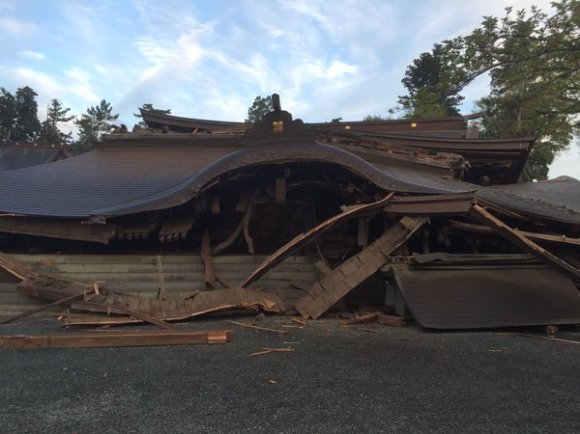
Both the shrine’s large gate and hall of worship have collapsed.
As earthquakes and aftershocks continue to hit Kumamoto Prefecture and the rest of the island of Kyushu, the destruction only increases. Following the first big earthquake on April 14, the Kyushu has been hit with seemingly ceaseless tremors, and at the time of this writing, over 30 lives have been lost. Damage to roads — caused directly by the earthquakes and landslides — has been extensive, and at around 2:45 p.m. on April 16, NHK reported that 1,000 people were stranded at a Tokai University campus in Minami Aso, though the Japan Self-Defense Forces are working to clear a path. Kumamoto Castle, which has stood strong for 400 years, has also suffered extensive damage.
Perhaps some of the most shocking images to emerge from the ongoing earthquakes are of the collapse of the romon (a two-story gate) and haiden (a “hall of worship”) at Aso Jinja, one of Japan’s oldest and most popular shrines. Though the date of the shrine’s foundation is unknown, the romon, one of the three largest in Japan, was constructed in the 19th century.
▼ An old photo of the romon (gate) at Aso Shrine
Both the romon and the haiden collapsed Saturday morning at around 1:25 a.m. when a particularly strong earthquake hit. In the tweet below, the top two photos show the romon and haiden before the destruction and now.
▼ “The two photos at the top are pictures I took four years ago when I visited with my family. The two on the bottom are of the same structures, which were demolished in the earthquake. This is Aso Shrine, which has a history stretching back over a thousand years and is home to one of Japan’s three largest romon (gates). I am saddened at the loss of a shrine that was full of the prayers and memories of many people, including my family.”
As the earthquake hit in the middle of the night, the full extent of the damage remained unknown util dawn broke. These photos, taken around 6 a.m., show the gate and hall completely collapsed.
▼ The romon (gate)
▼ The haiden (hall of worship)
▼ This video shows the breadth of the collapsed hall.
At the end, you can see the back of the collapsed gate.
▼ An aerial photo of Aso Shrine taken by the Asahi Shinbun
The earthquakes have not yet abated, but this is hardly the only problem local residents are currently facing. With extremely heavy rain in the forecast, some Aso City residents have been advised to evacuate for fear of landslides. In addition, Mount Aso, the largest active volcano in Japan, had a small eruption earlier in the day, spewing smoke 100 meters (about 328 feet) into the air. At this point, it is uncertain if the eruption was connected to the ongoing earthquakes or not, and the Meteorological Agency has maintained the volcanic alert at level two (out of five).
Sources: Net Lab, Twitter/@tomoyan8826, The Agency for Cultural Affairs, Mainichi Shinbun
Featured image: Twitter/@tomoyan8826